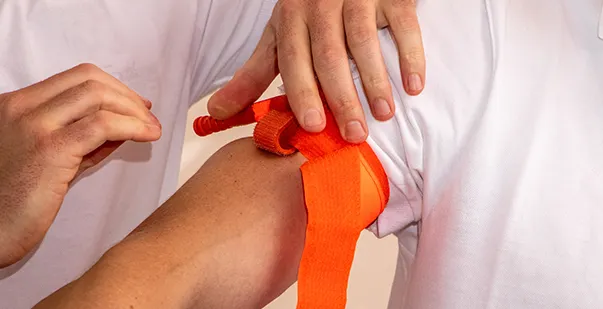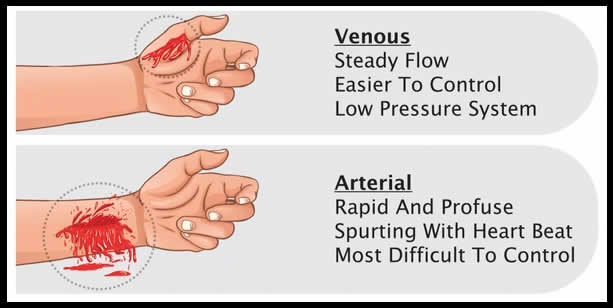
Last Updated On: January 2, 2025
Bleeding injuries can happen to anyone, but not all bleeding is the same. A person can bleed due to an injury in the artery or vein. The bleeding between the two differs in severity, appearance, and treatment. If you identify the type of bleeding, then it will be easier to provide the appropriate treatment. So, let’s find out how venous vs arterial bleeding differs and what first aid steps you should take to manage both.
The human body relies on blood vessels to transport blood throughout the body. There are two main types of blood vessels: veins and arteries, and they serve different but equally important roles.
Veins carry deoxygenated blood from the body’s tissues back to the heart. This blood is lower in oxygen and appears darker in color, often maroon or dark red. Veins are typically located closer to the surface of the skin, which is why they are commonly affected by minor cuts and injuries. The blood in veins flows under low pressure, resulting in a steady or oozing flow if a vein is damaged.
Arteries transport oxygen-rich blood away from the heart to nourish the body’s organs and tissues. They carry blood under high pressure and are located deeper within the body to provide extra protection. When an artery is damaged, the bleeding is often severe, with bright red blood spurting or pulsing in rhythm with the heartbeat.
When veins or arteries are injured, the resulting bleeding can be different. If you identify the type of blood vessel injury, you can provide appropriate first aid.
When a vein is cut or damaged, venous bleeding occurs. Veins operate under low pressure, so the bleeding is generally less forceful than arterial bleeding. Venous bleeding can look scary, but it is generally easier to control than arterial bleeding. You can manage it by applying firm pressure and elevating the affected area. However, if it doesn’t stop within 10 minutes, you need to get help from a professional right away.
Venous blood is dark red or maroon because it carries less oxygen. It flows steadily or oozes rather than spurts. Venous bleeding can occur due to deep cuts or lacerations, as they often damage veins near the surface. Arms and legs have veins close to the skin, and hence, the veins are more likely to bleed in case of an injury. Sometimes, surgeries can also lead to venous bleeding if veins are not properly sealed.
Arterial bleeding occurs when an artery is damaged or cut. Since arteries carry oxygen-rich blood from the heart to the rest of the body under high pressure, this type of bleeding is far more severe and harder to control than venous bleeding. Arterial bleeding is life-threatening and requires immediate medical attention. If not controlled quickly, the injured person can lose a large amount of blood in a short time. Thus, you must always call for emergency help in such situations.
Arterial blood is bright red because it is full of oxygen. The blood spurts or pulses in rhythm with the heartbeat. This forceful flow makes arterial bleeding harder to stop. Arterial bleeding can occur due to major accidents like car crashes that can sever arteries. Broken bones can also puncture nearby arteries and cause bleeding. Gunshot wounds or similar injuries can also damage arteries and result in arterial bleeding. They occur mostly during injuries in the neck, thigh, or abdomen.
Venous and arterial bleeding differ in how they look, their severity, and how they need to be treated. You need to understand the differences so that you can respond correctly in an emergency. The differences in bleeding types are summarized in the table below:
| Aspect | Venous Bleeding | Arterial Bleeding |
| Blood Color | The blood is usually dark red or maroon. | The blood is bright red colored. |
| Flow of Blood | The blood flow is steady or oozing. | The blood flow is spurting or pulsing with a heartbeat. |
| Pressure | Blood flows with low pressure. | Blood flows with high pressure. |
| Severity | Bleeding is easier to control and is less life-threatening. | Blood is harder to control and is more life-threatening. |
| Control Capability | Easier to control with direct pressure and elevation. | Difficult to control; may require a tourniquet in severe cases. |
| Common Locations | It occurs near the skin’s surface. | It occurs in deeper parts of the body. |
| Symptoms of Shock | Less likely to cause immediate shock; may lead to lightheadedness with significant blood loss. | Rapid onset of shock due to quick blood loss; signs include confusion and weakness. |
| Common Causes | Often results from minor cuts, lacerations, or punctures. | Typically results from traumatic injuries, deep cuts, or gunshot wounds. |

Venous bleeding is easier to control. Timely intervention can avoid severe blood loss and prevent infection. If you know the main first aid steps , you can easily stop it during an emergency and then call for medical help. So, follow these steps carefully to help someone dealing with venous bleeding:
Start by placing a clean cloth or a sterile dressing directly on the wound. Use your hand to press firmly over the area. Applying pressure helps slow the bleeding by compressing the injured vein. If you don’t have a cloth or bandage, use your hand, but make sure your hands are clean to avoid infection.
If the bleeding is on an arm or a leg, raise the limb above the level of the heart. This reduces the flow of blood to the injured area, which can help slow the bleeding. Support the limb with a pillow or hold it up gently. Be careful not to move the person too much if they are injured elsewhere.
Once the bleeding begins to slow, use a bandage or adhesive tape to secure the dressing in place. Wrap the bandage snugly but not so tight that it cuts off circulation. Check that the area below the bandage still feels warm and looks normal.
Watch the injured person closely for signs of shock, such as pale skin, dizziness, confusion, or fainting. If you notice any of these, lay the person down and keep their legs elevated unless it causes pain.
If the bleeding does not stop after 10 minutes of firm pressure or the wound is deep, contact a healthcare professional right away. It’s better to get help quickly to avoid complications like infection or excessive blood loss.
According to studies, hemorrhage is usually responsible for 40% of trauma patient admissions, and arterial bleeding is one of the main reasons behind it. This type of bleeding is extremely dangerous because blood loss is faster due to high pressure. Thus, you have to be very quick when facing an emergency where a victim suffered arterial bleeding. The steps for arterial hemorrhage management are:
Dial for emergency help immediately. Arterial bleeding is a life-threatening emergency, and professional medical assistance is essential. Clearly explain the situation and your location so that help arrives as quickly as possible.
Use a clean cloth, sterile dressing, or even your hand to press directly on the wound. Apply firm and steady pressure to slow the blood flow. If possible, use both hands to ensure enough force. Don’t worry about causing discomfort, as stopping the bleeding is the top priority.
If the bleeding doesn’t stop and the wound is on a limb, apply a tourniquet. Wrap it 2–3 inches above the injury, avoiding joints, and tighten it until the bleeding stops. Note the exact time you applied the tourniquet and share this information with medical responders. Only use a tourniquet if you have training, as improper use can cause damage.
If blood soaks through the first cloth or bandage, do not remove it. Instead, place another dressing on top and continue applying firm pressure. The bleeding can worsen if you remove the dressing can worsen the bleeding.
You need to ask the patient to remain calm and still, as movement can increase blood flow and make it difficult for you or the medical professional to manage the bleeding.
Watch for changes in breathing or consciousness. If the person becomes unresponsive, prepare to perform CPR if you are trained while waiting for emergency services to arrive.
For venous bleeding, provide first aid for the bleeding wound. If the bleeding doesn’t stop after applying firm pressure for 10 minutes, it’s essential to contact a healthcare provider with cpr certification. If the wound is too deep or large it may require stitches or other treatments. Hence, medical help is required. Watch for signs of infection, such as redness, swelling, warmth around the wound, or pus. These symptoms indicate that the wound needs medical care to prevent complications.
Always call emergency services immediately for arterial bleeding. As the blood loss is rapid and severe in arterial bleeding, it is a medical emergency that cannot wait. Even if you’ve managed to control the bleeding temporarily, the person will still need professional care to prevent further damage.
When you know the difference between venous vs arterial bleeding, you can perform the important first aid steps and save the victim’s life. Venous bleeding is easier to manage, but if not treated properly can lead to infections. Arterial bleeding is far more severe and demands immediate action to control blood loss until medical help arrives.
If you notice signs of severe bleeding or if the bleeding doesn’t stop after applying pressure, always seek medical help immediately. You can also consider enrolling in a certified first aid course. Learn how to handle bleeding emergencies confidently!
Read More: